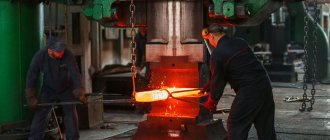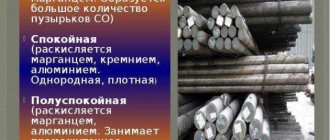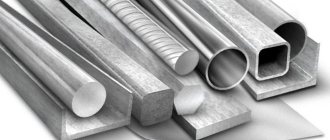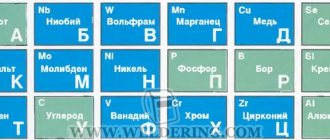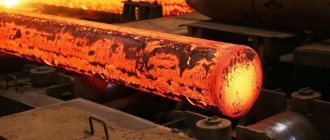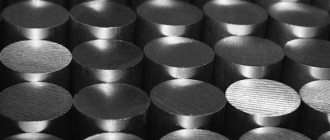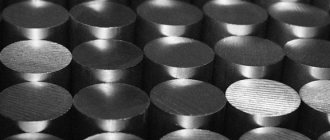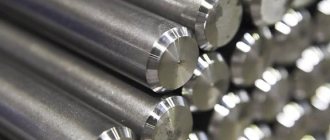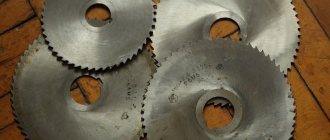01/19/2022 Author: VT-METALL
From this material you will learn
:
- Differences between alloy steel and carbon steel
- Alloying additives for steel
- Types of Alloy Steel
- Marking of alloy steels
- Applications of alloy steel
An alloy containing less than 45% iron is called steel. In addition to iron, the usual one includes carbon and various impurities. Alloy steel contains additional elements, so-called alloying elements. They are necessary to give the material different properties.
Depending on these additives, alloy steel acquires characteristics that contribute to its wider use. Due to alloying elements, it becomes resistant to the external environment, ductility and strength increase, and qualities that are required to solve certain problems appear. Our article will help you understand the types and grades of alloy steel, as well as its purpose.
Carbon steels: features, classification, processing and application
Carbon steel is a metallurgical composition with a low content of additives and a high iron content - up to 99 ½%. This material is in high demand in various industries, which explains its high share in production - up to 80%. Today, about 2 thousand brands have been developed. The structure of a material depends on its carbon content. By changing the percentage you can influence characteristics such as hardness, fluidity, ductility and density. The carbon content of the material is critical at 0.8%.
Regarding this indicator, the US is distinguished:
- if C is less than 0.8%, ferrite and pearlite are present in the structure of the material;
- at a C (carbon) content of 0.8%, the material is characterized by a pearlite structure;
- when the C content is more than 0.8%, cementite appears in the structure.
The general trend with increasing C content is expressed in an increase in strength, impact strength and cold brittleness threshold, but the ductility of rolled products decreases.
Alloying additives for steel
Chemical elements belonging to different groups of the periodic table are added to alloy steels.
Alloying metals in the Russian marking of alloy steels are designated using the Cyrillic alphabet. With their help, the qualities of the material are changed:
- Nickel (N)
. An increase in heat capacity, viscosity, and ductility, with a parallel decrease in fragility, which simplifies the processing of metal by pressure. - Chrome (X)
. Increased hardness and impact resistance. The additive provides good protection against rust - it is for this reason that there is always a lot of chromium in stainless steel. - Niobium (B)
. Increased resistance to acids. - Cobalt (K)
. Improvement of indicators such as resistance to shock and high temperatures. - Copper (D)
. Increasing the strength of alloy steel, however, when using this alloying element, the level of viscosity is slightly reduced. This component is usually added to make construction steel. - Titanium (T) and zirconium (Z)
. Reducing the level of grain size, since these metals provide a homogeneous structure, reduces the likelihood of cracking. - Tungsten (B) and molybdenum (M)
. Increased strength during heat treatment, corrosion resistance. - Aluminum (U)
. Increased resistance to scale when exposed to high temperatures. - Vanadium (F)
. Improving the structure, providing higher heat resistance.
Non-metallic additives are also added to alloy steels
:
- Manganese (G)
. Reducing the harmful effects of sulfur, phosphorus and oxygen. - Silicon (C)
. Increased strength while maintaining viscosity. - Selenium (E)
. Increased fluidity, easier mechanical processing. - Boron (R)
. Improved microstructure, increased hardenability. - Nitrogen (A)
. Providing improved mechanical properties - this component is added to high-alloy steels.
Classification of carbon steels
In addition to classification by structural parameters, they are usually distinguished by production technology:
- electric control systems;
- open hearth;
- oxygen converter.
The material is divided according to the level of deoxidation:
In terms of quality, in accordance with the presence and volume of harmful impurities, the iron alloy is:
- normal quality;
- quality steel.
According to the scope of use of the control system there are:
- ordinary;
- instrumental;
- structural.
Based on the presence and volume of C in the carbon iron alloy, the material is classified:
- high-carbon steel grades with a C content of more than 0.65%;
- medium carbon - from 0.25 to 0.6%;
- low-carbon steel grades with a C content of up to 0.25%.
The higher the carbon indicators, the harder and stronger the material, but also the higher its fragility. The marking of a material is directly related to its purpose:
- Ordinary quality is designated by the conventional letter designation Art. This is followed by numbers from 1 to 7, which show the C (carbon) content, a multiple of 10. The production of iron alloys of this group is regulated by GOST 380-85. Additionally, these materials are usually distinguished by supply group: A, B and C. This designation is indicated before the brand (group A is not indicated). For A - the mechanical properties are stable, for B the mechanical composition is stable, for C the properties and composition are stable.
- Structural control systems are regulated by GOST 380-88, marking is carried out with numbers: from 08 to 85. These numbers inform about the C (carbon) content in the material in hundredths of a percent. If an iron alloy is characterized by an increased manganese content, G is indicated at the end of the marking.
- Instrumental control systems are regulated by GOST 1435-54 and 5952-51. This iron alloy is of high quality and is marked with the letter U. This is followed by numbers that show the volume of carbon in tenths of a percent. There is a subgroup of the highest quality, in this case the designation ends with the letter A. They are characterized by a high carbon content.
It is customary to indicate the degree of deoxidation in the brand designation: ps or ks.
The percentage of C in the composition of tool steel is determined by its use. U7 - for the production of forging hammers, dies and chisels, U8 is used for the production of tools for working with stone and metal, U9 is optimal for the production of stamps and punches. Subsequent modifications are used to produce blades of hacksaws, drills, dies, and cutters.
Types of Alloy Steel
There are three main categories of such steels, the classification of which takes into account the proportion of impurities and alloying additives.
- Low alloy steel
– its composition contains approximately 2.5% alloying elements. - Medium alloy steel
- includes 2.5–10% alloying substances. - High-alloy steel
- contains more than 10% of the additives we are interested in, and their content can reach up to 50%.
The properties of the metal depend on the proportion of carbon. If its amount is 0.25–2.14%, the steel is carbon and is classified as follows:
- high carbon: 0.6–2%;
- medium carbon: 0.3–0.6%;
- low carbon: no more than 0.25%.
Adding new components is impossible without removing some of the old ones, otherwise linking is impossible. Purification allows you to reduce the share of harmful impurities and oxygen. Carbon is removed by burning due to the precipitation of carbides and other methods. Additives can be added to any steel, but this procedure does not always give the desired result.
In alloy steel, the carbon component is indicated in hundredths of a percent. There is a classification of alloy steels based on the total mass of additives:
- low alloyed – up to 2.5%;
- medium alloyed – 2.5–10%;
- highly alloyed - from 10%.
Due to the content of additives in alloy steel, recrystallization and the formation of a new structure occur. Based on the shape of the crystal lattice, the following classes of steel are distinguished:
- Ferrites
. Magnetic, the lattice is unstable, changes as a result of heating, cooling, transforming into perlite, sorbitol, trostite. This group includes all low-alloy and carbon steels.
It is possible to ensure the formation of stable bonds by reducing the proportion of carbon to 0.15% and adding chromium as an alloying component.
- Austenites
. They are characterized by a high content of nickel, chromium and manganese. Due to their structural structure, they are heat-resistant, plastic, and are not afraid of rust. This group includes chromium-nickel stainless steels.
- Martensites
. Cooling after quenching leads to martensitic transformation, resulting in the formation of cubic cells that make up needle or lath crystals. The metal acquires memory, so it is able to partially recover after deformation.
Steels containing chromium, molybdenum, vanadium, tungsten, niobium and other components that provide heat resistance can go into this state.
The metal crystal lattice is organized in the form of phases - most often there are two phases at once. Let's say there can be austenite and ferrite. The required phase is increased using additives and exposure to temperature.
During smelting, cast iron is obtained from ore, which is refined, that is, purified from gases, oxides, and other inclusions. Oxygen is removed with coal, slag, manganese and other deoxidizers - they cause the formation of gases or heavy oxides that precipitate.
The process of decarburization, or carbon removal, from alloy steel uses hydrogen and burns out the carbides, which releases carbon monoxide and forms scale. At the moment, some enterprises use modern technologies, such as gas-oxygen refining.
The quality of the metal depends on the result of these procedures. Based on this feature, the following steels are distinguished:
- Ordinary, or ordinary
. This is the cheapest material with a carbon content of around 0.6%, while there are air bubbles in the metal. The most common brands are: STO, St3sp, St5kp. - High quality
. This includes calm, semi-calm and boiling species, which contain oxygen, nitrogen, and hydrogen. In this case, the maximum concentration of gases is achieved in boiling water. Steels can be carbon and alloyed grades St08kp, St10ps, St20, 7ХФ, 8ХФ. - High quality
. They are distinguished by a reduced content of sulfur and phosphorus - within 0.03%. These steels are smelted in electric furnaces without the use of coal. These include 6ХВ2С, 6Х3ФС. - Particularly high quality
. Hot metal undergoes deep cleaning to remove oxides, sulfides, and non-metallic inclusions. As a result, up to 0.01% sulfur and 0.025% phosphorus remain in it. We are talking, for example, about a brand such as 30ХГС3-Ш.
In addition, there is a classification of alloy steels based on their purpose
:
Structural
They are used for the production of building structures and loaded mechanisms.
Types of structural alloy steels:
- Improveable. They stand out against the general background due to their high chromium content, enriched with boron, nickel, molybdenum, manganese, and are used for heat treatment.
- Spring-spring. They contain added silicon, cobalt, manganese, boron, titanium, and are used in the production of transport.
- Bearing. They are characterized by increased hardness and wear resistance, always contain chromium and a minimum content of non-metallic additives.
- Heat resistant. Used in the production of steam heaters.
Tool (cutting and stamping)
Additives added to tool alloy steels are responsible for increased strength and uniformity. Most often, the metal undergoes heat treatment and is used for the manufacture of cutters, cutters, and taps. Alloying is carried out with chromium, vanadium, titanium and other components.
Such steels are very expensive and high-speed, which is why they are used exclusively in cutting planes. For measuring instruments, chromium, tungsten, and manganese are added to the metal, ensuring its hardness and dimensional stability.
Steels with special properties, namely stainless, heat-resistant, wear-resistant, etc.
We are talking about a significant group, the metals in which have different properties:
- High-strength – high-alloy steels with a selected composition, thanks to which the metal is used for the production of critical components of mechanisms.
- Stainless steel - includes manganese, chromium, suitable for working in chemically aggressive environments, used for the production of pipes.
- Wear-resistant - characterized by a high proportion of manganese. They are used to make railroad switches, tracks, mining equipment, and excavator buckets.
In addition to the mentioned steels, this group includes heat-resistant, heat-resistant, magnetic, non-magnetic, rheostatic, and with high electrical resistance.
Modern alloys are complex alloyed compounds with unique characteristics. Thus, 15Kh2NMFA steel is designed to ensure the radiation life of a reactor installation for 100 years, and 17KhNGT is used as a material for special-purpose springs.
The difference between carbon steels and alloy steels
US grades distinguish between technological processes and the use of various additives. So what is the difference between carbon steels and alloy steels if elements are also added to these iron alloys that change the mechanical, operational and technological parameters:
- Carbon iron alloys contain iron, carbon and normal impurities, which can be beneficial or harmful. The first include manganese and silicon. Harmful impurities are sulfur and phosphorus.
- The material does not contain alloying additives that change properties, such as molybdenum, titanium, tungsten and others.
- CS are not intended for special use; it is a general industrial material.
- Compared to alloyed materials, carbon alloys have lower technological and operational parameters, including hardness and heat resistance.
Applications of alloy steel
Alloy steel is widely used in industry today. Its high strength allows it to be used in the production of equipment for cutting and chopping different types of rolled metal.
At the moment, alloy steels are used in a variety of fields, here are some of them:
- medical instruments, including sharp cutting objects;
- blades;
- bearings, parts experiencing high radial and support loads;
- cutters, cutters, drills, other equipment for machine tools in the field of metalworking;
- housings for equipment and devices;
- stainless steel utensils, such as buckets, basins, etc.;
- parts for the automotive industry.
From a practical point of view, among alloy steels there are:
- Mechanical engineering, used for the production of mechanism parts and body structures. They must be subjected to heat treatment.
- Construction materials, they are most often used for the manufacture of welded metal structures and only in rare cases are they subjected to strong heating.
This alloy steel is a material for three groups of tools:
- cutting;
- measuring;
- stamps.
Low-alloy steel is used to produce the bodies of railway cars, subway cars, trams, load-bearing structures of locomotives, agricultural and other field machines. This steel also serves as a material for engineering structures operating under variable dynamic loads, seasonal and daily heat changes.
Alloy steels can have different properties, which they obtain due to the ratio of the main elements. However, you need to understand how any alloy steel differs. What makes it stand out from the general background is its increased strength and resistance to rust formation.
Scope of application of carbon steels
The scope of application of the control system is determined by the type. Thus, low-carbon steel is used for cold deformation and hot forging; its grades are characterized by high ductility. Iron alloys with an average carbon content differ slightly in terms of fluidity and ductility, but its strength is already higher. They are relevant for the production of structural elements and mechanisms that will be used under normal conditions. CWs with a high carbon content have high strength; various tools and measuring instruments are made from them. Standard quality control is used in the production of sheet material, channels, rods, beams and other products. Machine elements and metal structures are made from it.
Features of welding medium-carbon steels
High C content is the cause of welding problems, such as:
- probability of formation of crystallization cracks;
- the appearance of brittle structures and cracking;
- the difficulty of obtaining the same strength of the weld and the base metal.
The following measures will help you eliminate potential problems and get a quality connection:
- Reducing the amount of C in the weld metal . To solve this problem, low-carbon electrode rods and wire are used.
- Providing preliminary and accompanying heating of the seam . Heating is usually carried out to +250…+300°C. This is one of the measures to prevent the formation of brittle hardened structures. The higher the C content, the higher the heating temperature should be.
- Modification of the metal of the weld area . The proportion of base metal can be reduced and the proportion of electrode metal in the weld can be increased by using welding wire of small cross-section and low welding current. Welding with direct current of straight polarity shows good results.
- Welding steel elements of significant thickness in a slide or cascade and slowing down the cooling of the seam . Such measures make it possible to eliminate the conditions for the formation of brittle hardening structures.
- Welding of heat-strengthened grades is carried out with long beads along previously laid and already cooled beads . This technology ensures equal strength of the weld metal and the heat-affected zone.
Submerged arc welding is not common for medium-carbon steels, since in this case it loses its main advantage - high productivity. To equalize the characteristics of strength and ductility of the weld and the base metal, heat treatment is used, usually quenching + tempering.
Carbon steel processing
The main types of carbon processing are: annealing, hardening, normalization, aging and tempering.
- Carbon steels of ordinary quality. Group A alloy is supplied for products that are not processed. Group B - these are materials that are intended for stamping, forging, and sometimes heat treatment. Group B is alloys that can be processed by welding.
- High quality carbon steel. This material can be subjected to thermal processing, normalization, cold machining, upset, stamping and pressure processing. Features of the technological process depend on the specific brand.
One of the main advantages of this iron alloy is its low cost. It is this factor that determines the wide applicability of the material.
Marking of alloy steels
The category of alloyed steels includes a wide variety of steels, which necessitated the need to systematize their alphanumeric designations. The requirements for their marking are specified by GOST 4543-71, according to which alloys endowed with special properties are indicated by markings with a letter in the first position. By this letter it is possible to determine that the steel, by its properties, belongs to a certain group.
An example of deciphering alloy steel markings
So, if the marking of alloy steels begins with the letters “F”, “X” or “E” - we have an alloy of the stainless, chromium or magnetic group. Steel, which belongs to the stainless chromium-nickel group, is designated by the letter “I” in its marking. Alloys belonging to the category of ball bearing and high-speed tool alloys are designated by the letters “Ш” and “Р”.
Steels classified as alloyed may belong to the category of high-quality, as well as especially high-quality. In such cases, the letter “A” or “W” is placed at the end of their mark, respectively. Steels of ordinary quality do not have such designations in their markings. Alloys that are produced by the rolling method also have a special designation. In this case, the marking contains the letter “N” (hard-worked rolled steel) or “TO” (heat-treated rolled steel).
The exact chemical composition of any alloy steel can be found in regulatory documents and reference literature, but the ability to understand its markings also allows one to obtain such information. The first figure allows you to understand how much carbon (in hundredths of a percent) alloy steel contains. After this number, the brand lists the letter designations of alloying elements that are additionally contained.
Designation of alloying elements in steel markings
After each such letter the quantitative content of the specified element is indicated. This content is expressed in whole fractions. There may not be any number after the letter indicating the element. This means that its content in steel does not exceed 1.5%. State standard 4543-71 regulates the designation of alloying additives included in alloy steel: A - Nitrogen, B - Niobium, C - Tungsten, G - Manganese, D - Copper, K - Cobalt, M - Molybdenum, N - Nickel, P - Phosphorus, P - Boron, S - Silicon, T - Titanium, C - Zirconium, F - Vanadium, X - Chrome, Yu - Aluminum.
Low carbon steel and its main characteristics
Low-carbon steel is an alloy that does not contain alloying elements, has impurities and a low carbon content, up to 0.25%. This alloy contains manganese and silicon, but due to its low percentage (manganese - no more than 1%, silicon - no more than 0.8%), they do not have a noticeable alloying effect on the material. Low-carbon steel is soft and has a low manganese content.
Due to its softness, this alloy does not allow precise surface processing, but its softness, toughness and ductility make it possible to create cemented workpieces and parts for subsequent welding/cementation. The machinability of the alloy is very poor, the surface of the workpiece has many roughnesses. Carrying out precise processing is quite difficult.
Tool steels
Materials from a large and diverse group of tool brands are subject to specific requirements related to the specific application of the products made from them. The group also has its own subgroups. The main ones are alloys for:
For cutting tools
The main requirement for alloys of this group is the ability to maintain a given hardness, strength and heat resistance under prolonged mechanical and thermal loads.
Tool steel tool for cutting tools
Such alloys are very expensive, so cutting tools, as a rule, are not made entirely of tool materials, but use cutting plates or surfaces of other shapes, fused or fixed on a base made of structural grades. This allows you to significantly reduce the cost and extend the service life of the tool.
The group is also divided into:
- Carbon tool alloys. They contain from 0.5 to 1.3% carbon. Suitable for common cutting tools for mass use.
- Alloyed instrumental. To increase strength and heat resistance (up to 300 °C), alloying additives are used - chromium, vanadium and others from 1 to 3%. Drills, cutters and broaches are made from such materials.
- High-speed cutting. They are used for highly efficient progressive tools with high heat resistance - up to 660 °C.
The high cost of a progressive tool is more than compensated in the general case by increasing equipment productivity, reducing wear on machines per product, reducing labor intensity and increasing the rate of product production. The economic effect depends on the size of the series.
Steels for measuring instruments
The main requirement for materials in this group is stability of shape and size during measurement and storage.
Steel product for measuring instruments
The second most important property is the exceptional surface quality, good machinability and especially sandability. Of course, the requirements for wear resistance and hardness also remain in force. Both inexpensive carbon grades and those alloyed with chromium, nickel and other additives are used. Products are subjected to carburization and hardening to improve surface quality and increase wear resistance. Recently, with the development of advanced non-contact methods and measuring instruments, such as laser, ultrasonic and hardware-software integrated into machining centers, the need for alloys of this group has decreased somewhat. But they are still in demand both in pilot production and in the manufacture and verification of those very progressive measuring instruments.
Die steels
Alloys of this group must be particularly hard, hardenable and heat resistant. The main requirement for them is high wear resistance and constancy of the product’s shape. This includes alloys:
- Cold stamping. To the basic requirements - hardness, wear resistance, stability of shape and dimensions - are added heat resistance and high viscosity, since the products operate under conditions of high pressure and shock. They are made on the basis of chromium-containing alloys with the addition of other elements. Many varieties are interchangeable with high-speed ones.
- Hot stamping. The requirements for cold-formed alloys include increased strength and toughness at high temperatures (up to 500 °C) and high thermal conductivity to avoid overheating. Alloyed with high contents of chromium, vanadium, nickel, etc.
Roll steels
They are used for the manufacture of various rolls of rolling mills, knives for cutting metal, dies and punches. They are also used for the manufacture of unique highly loaded components of paper-making and mining equipment.
The following requirements are put forward to them:
- High hardenability to achieve the required strength throughout the entire part, sometimes reaching tens of meters. In this case, hardening is carried out with a slow cooling schedule in oil.
- Deep hardenability. To ensure consistency in the size and shape of the rolled product produced, it is important that the high-strength zone is not concentrated in the surface layer, but evenly penetrates the entire volume of the product, reaching a diameter of several meters, guaranteeing the specified rigidity of the entire roll. This is achieved by bringing carbon to 0.8%, special selection of alloys (including silicon and boron) and careful adherence to the heat treatment program, especially in terms of the cooling schedule.
- High wear resistance. Guarantees long-term uninterrupted operation of the entire rolling mill, stability of rolling parameters and reduced costs for unscheduled repairs and subsequent adjustment of equipment.
- Sufficient contact strength. The value of the parameter with a given margin must exceed the stresses arising during the technological process, taking into account both the loads from the weight of the equipment itself and those arising due to the resistance of the rolled material.
- Minimization of own deformations, misalignment and warping during heat treatment, as well as the maximum possible stability of the shape and dimensions of the product during its operation.
The list of requirements ends with acceptable machinability of products and excellent grindability and polishability of surfaces. This will allow us to obtain consistently high quality rolled products.
Properties of Low Carbon Steel
The properties of low carbon steel do not have high strength values. Plasticity and viscosity, on the contrary, are high. Low-carbon steel grades are sometimes intended for the manufacture of case-hardened products that require additional case-hardening to achieve the required hardness and make them wear-resistant through further processing. Products made from such steel are quite well welded and forged.
The properties of low-alloy steel do not allow full-fledged work with this metal. However, if the process of normalization and cold drawing is carried out, the machinability of the surface can be significantly increased. Due to good ductility (5 = 33...23%), low-carbon steels can be successfully subjected to cold deformation, without losing mechanical properties, since local overstress is evenly distributed and cracks do not form. Such steel is weakly hardenable and welds well.
The properties of low-carbon steel have a number of disadvantages:
- low strength Te = 330...460 MPa, Sto.2 = 200...280 MPa;
- low impact strength;
- very sensitive to mechanical aging, since under repeated loads it senses stress concentrations, so products subject to repeated loads are not made from it.
Grades of low-carbon steel, their main areas of application
The grade of low-carbon steel, depending on its composition, has specific purposes in industry. This type of alloy includes 05 kp, 08, 10, 10 ps, which are actively used for the production of washers, gaskets and other light-loaded structural elements and machines. Depending on the grade of low-carbon steel , the alloy is used in different industries. Thus, high resistance to static hydrogen fatigue is demonstrated by:
The following grades of low-carbon steel are used as case-hardening steel:
In the manufacture of gears with subsequent cementation, the following is used:
- EP620;
- EP355;
- 03 are used as a charge billet and are produced in the form of rods of various sizes. This charge additive is used in the process of smelting special alloys for the manufacture of individual parts and special rolled products.
To create welded structures, the following grades of low-carbon steel :
- St0;
- St1sp;
- St1ps;
- St1kp;
- St2sp;
- St2ps;
- St2kl;
- St3sp;
- ST3kl (GOST 380);
- steel 10;
- steel 15;
- steel 20 (GOST 1050);
- S235-S295;
- P235-P295 (EN 10025, EN 10027-1, EN 10028-2).
Classification of steel by purpose
The following type of steel classification is by purpose:
- structural;
- instrumental;
- with special physical and chemical characteristics.
This classification is quite arbitrary; one group may contain dozens of brands, while another may contain one or two.
Classification of steels by purpose
In addition, many brands, due to their mechanical properties, are also suitable for related purposes. When choosing a brand for a specific design or part, designers and technologists take into account, in addition to the formal purpose, many more factors, such as price, machinability, compatibility with other parts in terms of the coefficient of thermal expansion, and others. Sometimes the designer uses a brand that is obviously superior in its parameters and cost to a simple structural grade that is quite suitable for a given part. This is acceptable in conditions of unique production or especially small series, high transport costs, and a number of other cases. Any such decision must be justified from a financial point of view.
Structural
Structural steels of ordinary quality represent one of the most extensive groups.
- construction;
- cold stamping;
- cemented;
- improved;
- high strength;
- spring-spring;
- bearing;
- automatic;
- corrosion resistant;
- wear-resistant;
- heat resistant and heat resistant.
Construction
This includes a large number of grades of ordinary carbon and low alloy alloys. Such materials are used to create complex spatial structures in which the load is evenly distributed between all elements. There are no special requirements for each of them, other than good weldability.
For cold stamping
During cold stamping, the shape of the workpiece and its dimensions change significantly, therefore, for this group of low-carbon high-quality alloys, the main requirement is different - high ductility and tensile strength.
Cementable
This group is used for the production of units and parts subject to friction and variable periodic loads. The cementation procedure serves to increase the surface's resistance to wear. It includes low-carbon (0.1-0.3%) and some alloyed alloys.
Case-hardened steel products
Upgradeable
These grades are intended for special types of heat treatment, such as hardening and tempering, used to improve the strength and other mechanical characteristics of the material. The group includes both medium carbon and chromium, including those with additives of boron, manganese, nickel and molybdenum.
High strength
For high-strength, medium-carbon, high-alloy alloys, the composition and ratio of additives, as well as specific heat treatment programs, are specially selected. As a result, metallurgists achieve strength characteristics that are two or more times greater than those of structural grades. They are used in particularly critical units.
Spring
The main feature of spring spring brands is the ability to undergo repeated elastic deformations without accumulating the effect of fatigue. They are very widely used in transport and mechanical engineering, wherever depreciation, damping of vibrations or ensuring the return of parts of the mechanism to their original position after performing a working movement is required. To increase the elastic limit, carbon alloys are alloyed with silicon, manganese, boron and other elements.
Bearing
To ensure the required service life of engines, machine tools and other mechanisms that use bearings, products made from alloys of this group must be high-strength, wear-resistant and durable. Foreign inclusions, inhomogeneities, and all types of pores should be minimized. Contains about one percent carbon and 0.8-1.5% chromium, subject to special compaction and heat treatment
Automatic
The main parameter for alloys of this group is high machinability, the formation of easily breaking short chips and reduced friction between the part and the tool. They are used for the production of mass series of fastening components on automated production complexes. Sulfur, lead, selenium and tellurium are added to the composition. The downside is the reduced ductility of the material.
Wear-resistant
By adding large quantities of manganese to the alloy, wear-resistant steel grades are obtained. Their purpose is the production of units subject to strong friction, including abrasive, and large static and dynamic loads. These are elements of switches on the rail track, mining equipment, loader buckets, and tracks.
Damper made of wear-resistant steel
Corrosion resistant stainless steel
These low-carbon alloys are heavily alloyed with chromium and manganese. During crystallization, chromium forms a thin surface layer of oxides that protects the part from exposure to chemically active environments. Such alloys can be used in both mildly aggressive (water, steam) and highly aggressive environments (solutions of acids, alkalis, sea water) at temperatures up to 60 °C
The corrosion-resistant group has its own classification
- Corrosion resistant. They are used to make shafts, springs, valves, and turbine blades that can withstand high loads and up to 600 °C.
- Heat resistant. Designed to operate at high temperatures (up to 1200 °C) under limited loads.
- Heat resistant. Low-carbon alloys highly alloyed with nickel, silicon and other additives can operate under conditions of both high temperatures (up to 75% of the melting point) and high loads.
- Cryogenic. Maintain elasticity and viscosity at low and especially low temperatures (down to -200 °C). They are used for the manufacture of components for industrial and scientific refrigeration units.
In their properties, these materials differ significantly from the well-known food grade stainless steel, from which dishes and kitchen equipment are made.
The essence of the improvement process
At the first stage of the process, the product being improved is subjected to annealing, the purpose of which is to relieve possible internal stresses. The annealing temperature range ranges from 680...7200C (for tool steels) to 800...9000C for structural steels. As the percentage of carbon increases, the annealing temperature is reduced.
Hardening is carried out under the same conditions as for single-stage hardening heat treatment operations (from 900 to 12000C), but after hardening there must be a high tempering, the temperature of which should not be lower than 500...7000C.
Improveable structural steels are amenable to heat treatment, the operation of which requires a combination of strength and toughness, which is ensured by the resulting structural component such as sorbitol. Representing granular pearlite with the presence of a certain amount of retained austenite, the structure of sorbitol is obligatory in the surface and subsurface layers.
To improve the structure and reduce deformation during heat treatment, quenching is carried out in oil. This reduces warping (especially in parts that are sharply uneven in cross-section) and helps improve the accuracy of improved products.
Vacation is most often carried out in calm air at a temperature of 580...6500C.
- The operational benefits of the improvement process include:
- Maximum possible hardness after hardening;
- High impact strength;
- Uniformity of properties in all directions;
- Low sensitivity to alternating loads.
The tempering mode, which affects the hardness of the part, is of utmost importance for compliance with the improvement technology. Spring steels are tempered at 450...550°C, the final hardness does not exceed 42...45 HRC. With an increase in tempering temperature to 550...6500C, the hardness reaches 62...65 HRC, which is typical for high-speed steels.
Upgrading quenching is usually performed in furnaces equipped with a shielding gas option. The shielding gas prevents surface oxidation during heat treatment, which is important for high-temperature batch furnaces.
For some types of products being improved, the holding time at the tempering temperature is of great importance; longer holding times will correspond to higher temperatures.
Depending on the grade of steel, in certain temperature ranges a dangerous phenomenon such as temper brittleness may occur. The areas of temper brittleness are established according to data from steel graders.
Alloy steels
By adding certain substances to the composition of steel alloys, the necessary properties can be achieved; this operation is called alloying. For example:
- Chromium - increases hardness, strength, corrosion resistance, but impairs ductility.
- Nickel - increases ductility and corrosion resistance, but can reduce hardness; it is often used together with manganese.
- Tungsten , molybdenum - impart hardness, enhance heat resistance, reduce brittleness during tempering.
- Manganese - optimizes impact resistance and hardness without compromising ductility.
- Aluminum – improves heat resistance, as well as scale resistance and corrosion resistance.
- Silicon – makes the metal strong while maintaining its toughness. Improves electrical resistance, elasticity, acid resistance. Compared to other alloying elements, it is less expensive.
Alloy steels, having unique qualities, are used for the production of products where they cannot be replaced by other materials. They are classified according to purpose, structure, percentage of alloying elements, and chemical composition.
Hardenability
Each steel has a “limiting” cross-sectional size, above which it is impossible to achieve full hardening (increase in hardness). To achieve optimal section properties, either a higher quality material or an increased cooling rate is required, possibly even using lower temperature coolants (continuous flow cooling).
However, higher quenching rates always increase the risk of warping or cracking, and rapid cooling reduces toughness.
The following factors influence hardenability:
- Percentage of aluminum and nitrogen. Some carbon and low-alloy steels contain more than 0.3 ... 0.5% aluminum (added for deoxidation), which reduces hardness after hardening. The effect of nitrogen is the same;
- The presence of an uncontrolled atmosphere inside the hardening furnace. In furnaces with a protective atmosphere, hardenability always increases;
- The presence of nickel and chromium in the chemical composition reduces the depth of the hardened layer at high quenching temperatures, and when the cooling rate increases, it promotes temper brittleness. To maintain the required sorbitol structure, tempering is carried out at the highest possible temperatures. If the hardness indicators are unsatisfactory, they resort to cold hardening.
For steels with a high carbon content (high-speed), hardenability is also affected by surface decarburization.
Classification and grades of improved steels
According to operating conditions, such steels are used for critical parts of gear drives - gears, gear shafts, gears, which operate under conditions of both normal and cyclic alternating loads.
Operational durability can be achieved by a combination of two heat treatment schemes: hardening of the surface layer (hardening, not only flame, but also electrical, using high-frequency currents) with a plastic-viscous inner layer, which is a kind of substrate for the surface volumes.
Typical brands:
- Structural medium-carbon (35, 45) according to GOST 1060-2012;
- Alloyed (mainly with chromium, nickel and/or molybdenum) medium-carbon structural grades 18ХГТ, 45Х, 40ХН, 45ХНМ, 35ХМ according to GOST 4543-91;
- High-speed cutting type P9 or P18 according to GOST 19265-73, used for the production of metal-cutting equipment;
- Spring springs of medium elasticity, for example, 65G according to GOST 14959-2016, which are used for the manufacture of rollers for slewing bearings of lifting cranes, or spring washers for critical purposes.
Almost all steels suitable for improvement are characterized by poor weldability.
